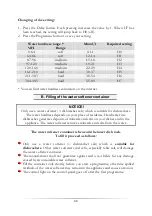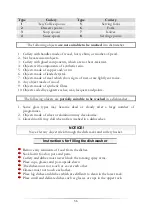
53
3.
without phosphate / without chlorine
Recent powdered dishwasher detergents usually do not contain any phosphate so
they do not soften the water. In such a case add a water softener(= dishwasher salt)
even if the hardness of water is e.g. 6dH. Otherwise white spots may occur on your
dishes and glasses.
Dishwasher detergents without chlorine only bleach slightly, so they do not remove
tough stains. In such a case select a programme with a higher temperature.
7. USE OF THE DISH RACKS
Observe the instructions given in this chapter to reach the best performance of
your appliance. The features and design of the racks depend on model.
Before and after filling the racks
1.
Remove residuals of food from the dishes.
2.
You do not need to rinse the dishes under flowing water.
3.
Fill the racks as follows:
a.
Objects such as cups, glasses, pots and pans upside down.
b.
Curved objects and objects with recesses in a slanted position, so the
water can drain off.
c.
Arrange the dishes safely and tightly in the rack so they cannot tip over.
d.
The dishes must not block the rotating spray arms.
e.
Do not put very small objects in the appliance as they may easily drop
out of the racks.
4.
After washing empty the lower rack first; so remaining water cannot drop from
the upper rack into the lower one.
Adjusting of the upper rack
You can adjust the position of the upper dish rack to provide more room for large
objects either in the lower or the upper rack. You adjust the upper rack by placing
the relevant wheel-set in the rail. Put long items on the shelf so they will not
impede the rotating spray arms. You can fold back the shelf if need be.
















































